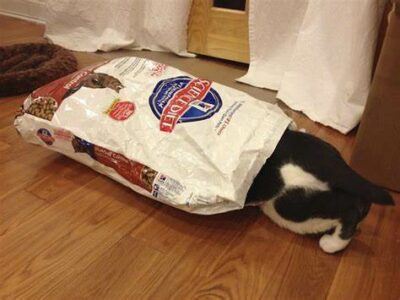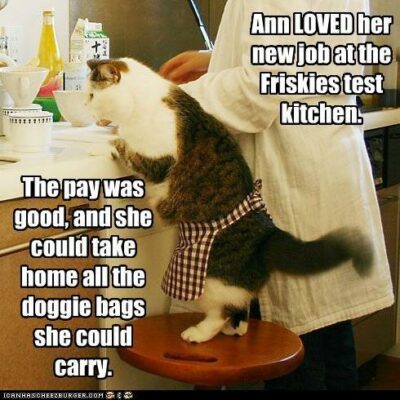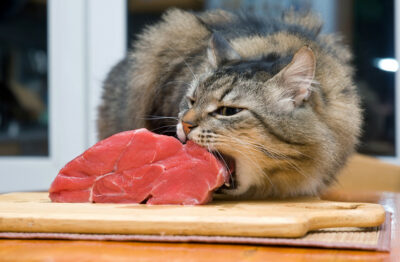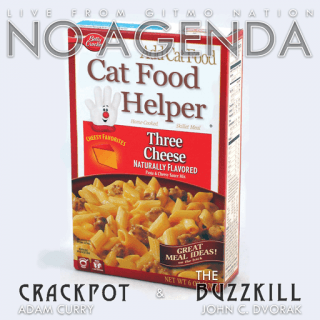Do you have to find a new cat food for your fur baby? You might have any of several reasons why you feel you must do so. Have you decided on a method that will allow you to change cat food with a minimum of trauma for you and the cat?
You might have several reasons why you need to change your kitty’s food. Let’s look at these. Which one fits your situation?
Fussy Eater: I’m starting with this one because I’ve had a couple of cats decide they didn’t like their food for this reason. When the cat decides he doesn’t like that food any more, it can turn meal-time into a frustrating scene for you if you can’t get kitty to eat.

I’ve often felt a bit sorry for cats when they have to eat the same food, day in and day out. However, if he eats the food willingly and it’s a good balanced and healthy food, not to worry. The cat may accept the same food daily as part of his routine.
If he does become bored with it, you could try a new flavor. Bottom line becomes whether he gets a sufficient amount of protein in his diet each day. If he does not eat at least three tablespoons of protein-based food every day, call your vet.
Age: A cat’s nutritional needs can change, depending on his stage of life. When still a kitten, his body requires a higher amount of fat and calories, as these help them grow. The basic difference between adult cat food and that for seniors: the diet for an older cat will contain more fiber.
This fiber promotes a sense of fullness, and may keep the older cat from eating too much. As his activity level has become lower, he may become obese if he overeats.
Health: A cat with a health problem may have differing dietary needs from one who has no such problems. For example, Mocha just had a UTI, and this has caused a diet change to Hill’s C/D, which is formulated for cats susceptible to such problems.
Just started him on that food, and fortunately, he likes it. Thank goodness!
The Safest Way To Change Kitty’s Food
Changing kitty’s food can cause some digestive problems if you make the switch too quickly. In the references I used, (see list at bottom of page) three of them outlined the same procedure for changing the food, so will use the steps they have listed.

Use A Seven-Day Transition Schedule:
- Day one to two: Serve your cat 1/4 portion of new food mixed with 3/4 portion of old food.
- Day three and four: Serve half new food and half old food.
- Day five and six: Serve 3/4 portion of new food with 1/4 portion of old food.
- Day seven: Serve just the new food.
For senior cats, (older than nine years) try a longer, 10-day transition period. Give 3/4 old food and 1/4 new for 3 days. Then on days four and five, give 50% of each. If you notice digestive problems, go back to giving less of the new food.
From day six to nine, give 3/4 new food and 1/4 old. If kitty does okay with this proportion, on day 10 you can give only the new food.
Signs of difficulty, meaning you should go back to the previous step, can include the following:
- soft stool
- vomiting
- diarrhea
- loss of appetite
Ways To Make The Transition Smoother
Provide a quiet, relaxing place for kitty to eat. The whole food change thing can be stressful, so if you can make meal-time a relaxing part of the day, quiet and stress-free, you will help kitty with this transition.
Serve wet food at body temperature. Food coming directly from the refrigerator has a very cold temperature. Give the food time to warm up. One reference suggests warming for a few seconds in a microwave. I don’t trust microwaves, so my warming method is a bit different.

I put a very small portion of very hot water in the food and mix it in, starting the warming process. Then, I put a couple of inches of that same temperature of hot water in the bottom of the sink, and set the bowl in it for a few minutes. It warms up nicely.
Serve in a flat dish or a very low-sided, wide bowl, so the whiskers will fit without bending
Try serving a small amount of food by hand.
When Should You Change Your Cat’s Food?
If you are unsure as to the need for a food change, talk with your vet. Describe your kitty’s situation and let the vet advise you when the change becomes necessary.
Most cats stop growing around one year of age, so then you can make the switch from kitten to adult food. During this time, watch kitty’s weight, and if they look under or overweight, adjust the portion of food you give them.
If kitty is more than 20% over their normal body weight, he fits in the pattern for obesity. He’s in good company, as 55% of the cats in the United States are overweight.
Consider A Rotating Diet
This technique represents the method I now use for feeding Mocha. I’ve found 3 foods that he eats enthusiastically, so I now rotate those. I usually give him one food for two to three days, and then switch to a different flavor. It seems to work.

Bottom line: find a food or two or three that your cat likes. Then, make sure he eats enough of them every day to remain healthy.
Does The New Food Work Well For Your Kitty?
Usually, transitioning to a new food becomes a relatively smooth process. However, at times the new food simply does not agree with your kitty’s system. Watch for these signs that might indicate the new diet creates problems:
- Vomiting
- Diarrhea
- Excess gas
- Weight loss
- Coat appears dry and dull
- Cat refuses food
- Lack of energy
- Itchiness
If kitty develops any of the signs above, it’s time to visit the vet. Perhaps kitty has an underlying issue, such as an allergy. The vet can suggest an alternative diet plan.
You Must Initiate The Change

Obviously, kitty cannot go to the market and select his own food. Can you imagine the things he might want in the shopping cart? You must decide what food might become the best choice for a food change.
At least, where you live, perhaps you can select a can or two of new food to see if kitty likes it. Here in my small Alaskan town, I have to order it by the case, and cannot get a refund. The choice becomes harder. However, even here, I’ve managed to find a way to make a food transition.
You can do it — it is important for your cat’s health and well-being. Good luck with transitioning!
References I used for this post:
petmd.com/cat/centers/nutrition/evr_ct_6-signs-its-time-to-change-your-cats-food wikihow.pet/Change-Cat-Food petsradar.com/advice/changing-cat-food petmd.com/cat/nutrition/changing-cats-food-how-to purina.com/articles/cat/feeding/changing-cat-food

